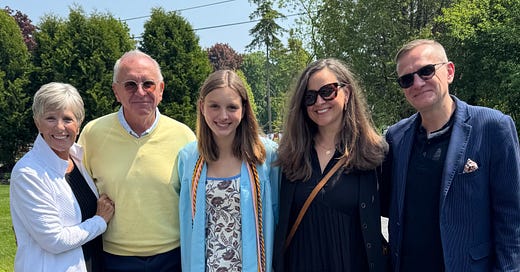The Unofficial Curriculum That Shaped My Life & Career
How a lifetime of curiosity—from childhood to parenthood—is the mindset every company needs now.
This past weekend was one of those full-heart moments you tuck away for life.
My daughter Lila graduated high school. Come fall, she’s off to UW–Madison to write her next chapter. It’s a huge milestone for her—and, I suppose, for me too. But I didn’t initially connect my parenting to the outcome. She’s smart, grounded, kind, and fiercely driven. As a parent, it doesn’t get better than that.
My parents came into town to celebrate, which made the moment even more special. Around the dinner table, between laughter and a few proud tears, we told stories. The rich “remember when” kind that only come out when generations gather.
One story from my dad stuck with me. The arena where Lila graduated? He watched high school state championship games there. He saw my sister walk the stage for her college graduation. And now, he watched his granddaughter celebrate a milestone moment in that same arena.
Same place. Three generations. A lifetime of memories.
A Moment of Reflection
That moment triggered some deep reflection for me. Not just about family, but about how I became who I am.
My parents didn’t raise me with a playbook, they let me chart my own course and raised me with curiosity. With exploration. With the freedom to get things wrong.
My dad pulled me out of school for “sick days” to go on fishing trips. He taught me how to use power tools in his woodshop and build things with my hands. We wandered computer stores filled with bulky software boxes and 16-bit games that rarely lived up to their cover art. I can still remember the “electronics” smell of those stores.
Those weren’t just good memories, they were foundational ones. He taught me to tinker. To think. To take things apart and try to put them back together—even if we didn’t know how.
That mindset stuck. It shaped how I live. It shaped how I lead. And most of all, it shaped my relationship with risk.
Curiosity Made Me Unafraid to Try
Trying, failing, succeeding, adjusting, repeating, that’s been the rhythm of my entire life and career.
Throughout my life, I’ve taken risks others would never take. Some paid off in big ways. Others didn’t. But I’ve never regretted a single one. Because I was raised to believe that the outcome isn’t the point. The learning is.
While above story centers around my dad’s influence, it would be incomplete without recognizing the steady presence of my mom. Her love, encouragement, and belief in me created the environment where curiosity could actually take root. Together, they raised me to explore, be my own person and no matter what happened, they always had my back.
My upbringing has guided me across startups, media giants, SaaS companies, and now into AI. It’s why I’m always experimenting, building, evolving. Not because I have all the answers, but because I never stop asking the questions.
A Corporate Reflection
Of course, it wouldn’t be a story from me if I didn’t zoom out and tie this back to the world I live in professionally.
The reflections about parenting—and the quiet power of curiosity—kept echoing as I thought about the work I do every day. Because what I’m seeing in companies right now, especially around AI, is not a lack of tools. It’s a lack of mindset.
Many organizations believe their biggest hurdle to adopting AI is technological, but it’s not.
It’s cultural. It’s human. It’s a crisis of curiosity.
We’ve engineered workplace cultures that reward predictability and punish exploration. Tight deadlines. Constant deliverables. “Show ROI before you try anything new.” As a result, teams sit back, wait for permission, and innovation dies before it ever gets a chance to breathe.
Meetings are run to stay on time, not to surface breakthrough ideas. Learning something “off script” is seen as a detour, not a differentiator. In our race for productivity, we’ve optimized for output, not for originality.
And here’s the kicker: the AI tools themselves? They’re incredible. But if curiosity is missing from the equation—if people are too overwhelmed, boxed in, or risk-averse to tinker and explore—those tools won’t even scratch the surface of what’s possible.
Here’s What I Know:
Curiosity doesn’t just fuel innovation. It fuels resilience. It’s what lets you take the hit and come back smarter. It’s what separates “playing not to lose” from “playing to build something better.”
And here’s the part I didn’t see clearly. Until this weekend.
While I was busy reflecting on how my parents shaped me, I realized: I had done the same for my daughter. I just didn’t really connect the dots until now.
The spontaneous weekend trips to New York (to hit my American Airlines qualifying year status). The travels across Europe. The gentle nudges to try new things, meet new people, explore unfamiliar places, ask better questions. I definately didn’t parent with a playbook but always encouraged being curious.
Just like they did.
Seeing her now—so poised to take on what’s next with confidence and curiosity—the throughline has never been more clear. She’s living out the same unofficial curriculum I was raised on: stay open, stay curious, and learn by doing. I learned it through thousands of micro-moments that shaped who I am. I lived it through every risk I’ve taken.
And I teach it now through the work I do—helping teams bring AI to life inside their organizations.
Not through hype. But through hands-on experimentation. And fostering a culture that supports trying, embraces failure, and promotes never-ending curiosity.
A Final Thought
This weekend was a quiet reminder of the mindset that shaped me, and why I’ll always bet on curiosity over certainty.
Because in a world moving this fast, the real competitive advantage isn’t who knows the most.
It’s who’s willing to keep learning, tinkering, failing and evolving.





What a great post. Thanks for sharing bud!